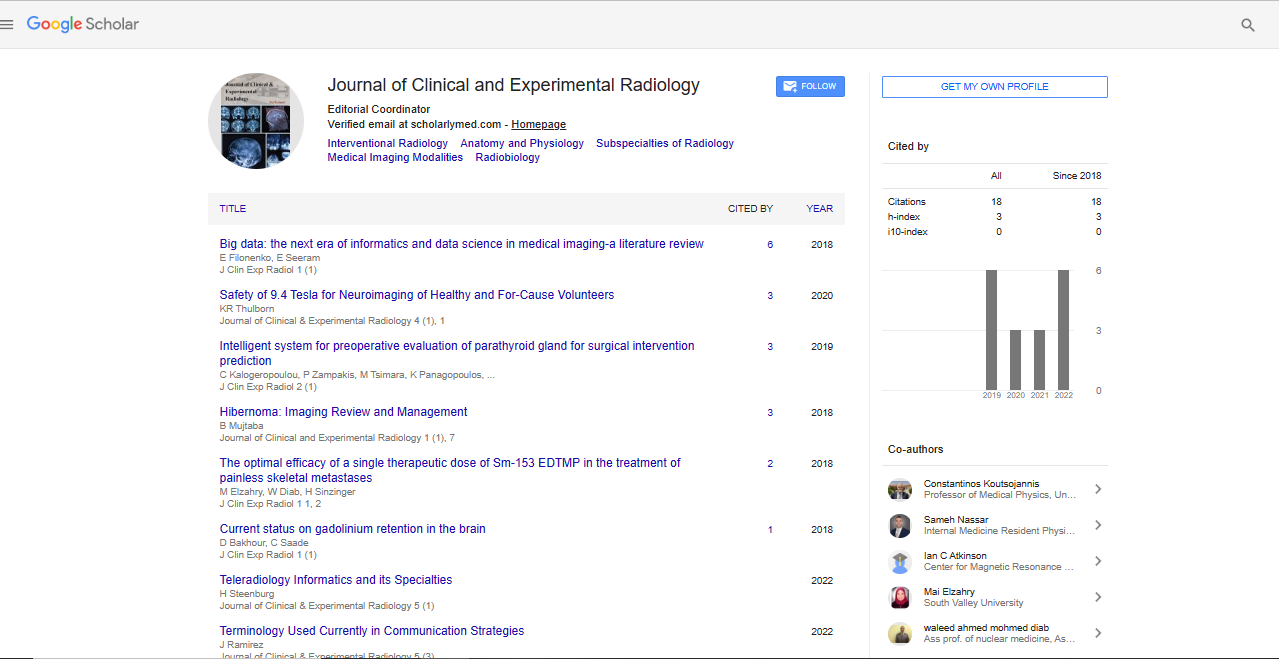Perspective, J Clin Expradiol Vol: 8 Issue: 1
Unveiling the Mind's Flow: Exploration of Cerebral Perfusion Studies
Karen J Limb*
1Department of Otolaryngology, University of California, San Francisco, CA, USA
*Corresponding Author: Karen J Limb,
Department of Otolaryngology, University of California, San Francisco, CA, USA
E-mail:karjlimb@gmail.com
Received date: 30 December, 2023, Manuscript No. JCER-24-124150;
Editor assigned date: 02 January, 2024, PreQC No. JCER-24-124150 (PQ);
Reviewed date: 16 January, 2024, QC No. JCER-24-124150;
Revised date: 18 February, 2025, Manuscript No. JCER-24-124150 (R);
Published date: 25 February, 2025, DOI: 10.4172/jcer.1000160
Citation: Limb KJ (2025) Unveiling the Mind's Flow: Exploration of Cerebral Perfusion Studies. J Clin ExpRadiol 8:1.
Introduction
The intricate dance of the human mind relies heavily on the delicate orchestration of cerebral perfusion the continuous supply of blood to the brain. Cerebral perfusion studies, a vital branch of medical imaging and diagnostics, offer a window into the dynamic interplay between blood flow and brain function. This manuscript delves into the significance, methodologies, and applications of cerebral perfusion studies, shedding light on their crucial role in understanding and managing neurological conditions.
Description
The significance of cerebral perfusion
Understanding cerebral blood flow: Cerebral perfusion is synonymous with cerebral blood flow, a process vital for delivering oxygen and nutrients to brain tissues. The brain's high metabolic demands make it particularly sensitive to changes in perfusion, and disruptions can have profound implications for neurological function.
Link to neurological disorders: Alterations in cerebral perfusion are implicated in various neurological disorders, including ischemic stroke, vascular dementia, and neurodegenerative conditions. Studying cerebral perfusion provides valuable insights into the mechanisms and progression of these disorders, paving the way for early detection and targeted interventions.
Methodologies in cerebral perfusion studies
Nuclear medicine techniques: Nuclear medicine plays a pivotal role in cerebral perfusion studies. Techniques such as Single Photon Emission Computed Tomography (SPECT) and Positron Emission Tomography (PET) utilize radiotracers to visualize blood flow patterns and identify regions of altered perfusion, offering a three-dimensional perspective.
Magnetic Resonance Imaging (MRI): Magnetic Resonance Imaging, specifically Arterial Spin Labeling (ASL), is another powerful tool in cerebral perfusion studies. ASL provides non-invasive, highresolution images of blood flow without the need for contrast agents, making it particularly suitable for repeated assessments and certain patient populations.
Applications in clinical practice
Ischemic stroke assessment: Cerebral perfusion studies are instrumental in evaluating ischemic stroke, providing critical information about the extent and location of compromised blood flow. Early identification of perfusion deficits aids in determining the optimal course of treatment, whether it be thrombolytic therapy or endovascular intervention.
Dementia and cognitive disorders: In the realm of neurodegenerative disorders, cerebral perfusion studies contribute to the diagnosis and understanding of conditions such as Alzheimer's disease and vascular dementia. By mapping regional blood flow, these studies aid in distinguishing different forms of dementia and assessing disease progression.
Emerging frontiers and innovations
Functional connectivity mapping: Recent advances in cerebral perfusion studies include exploring functional connectivity within the brain. By combining perfusion imaging with functional MRI, researchers can map networks of brain activity, providing insights into how different regions communicate and collaborate.
Cerebrovascular reserve studies: Cerebrovascular reserve studies assess the brain's ability to compensate for changes in blood flow. By challenging the vascular system and measuring the brain's response, these studies offer valuable information about an individual's resilience to perfusion changes and the risk of cerebrovascular events.
Challenges and future directions
Limitations in spatial and temporal resolution: Despite significant advancements, challenges persist in achieving high spatial and temporal resolution in cerebral perfusion studies. Overcoming these limitations is crucial for more precise mapping of blood flow patterns and enhancing the diagnostic accuracy of these studies.
Integration with multi-modal imaging: The future of cerebral perfusion studies lies in their integration with other imaging modalities, such as structural MRI and functional connectivity assessments. This multi-modal approach promises a more comprehensive understanding of brain health and dysfunction, paving the way for personalized medicine in neurological care.
Conclusion
Decoding the mind's circulation: Cerebral perfusion studies stand at the crossroads of technology, medicine, and neuroscience, offering a unique glimpse into the mind's circulation. As we unravel the intricacies of cerebral blood flow, we unlock the potential to decipher neurological mysteries, diagnose conditions with greater precision, and tailor interventions for optimal patient outcomes. The evolving landscape of cerebral perfusion studies promises not only to deepen our understanding of the brain but also to reshape the future of neurological diagnostics and care, ushering in an era where the mind's flow is decoded with unprecedented clarity and insight.
 Spanish
Spanish  Chinese
Chinese  Russian
Russian  German
German  French
French  Japanese
Japanese  Portuguese
Portuguese  Hindi
Hindi 